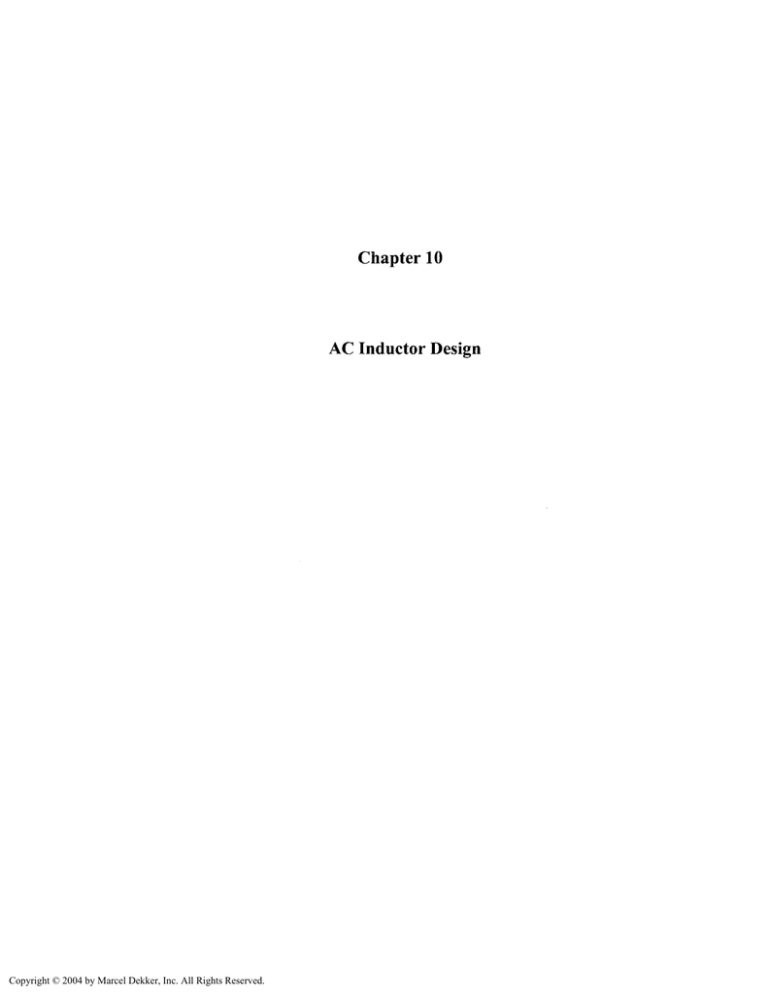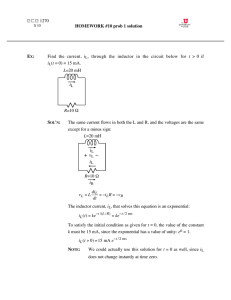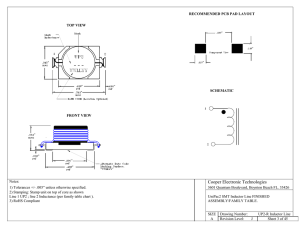
Chapter 10
AC Inductor Design
Copyright © 2004 by Marcel Dekker, Inc. All Rights Reserved.
Table of Contents
1. Introduction
2.
Requirements
3.
Relationship of, Ap, to the Inductor Volt-Amp Capability
4.
Relationship of, Kg, to the Inductor Volt-Amp Capability
5.
Fundamental Considerations
6.
Fringing Flux
7. AC Inductor Design Example
8.
Reference
Copyright © 2004 by Marcel Dekker, Inc. All Rights Reserved.
Introduction
The design of an ac inductor is quite similar to that of a transformer. If there is no dc flux in the core, the
design calculations are straightforward. The apparent power, Pt, of an inductor is the VA of the inductor;
that is, the product of the excitation voltage and the current through the inductor.
P,=yA, [watts] [10-1]
Requirements
The design of the ac inductor requires the calculation of the volt-amp (VA) capability.
In some
applications the inductance is specified, and in others, the current is specified. If the inductance is
specified, then, the current has to be calculated. If the current is specified, then the inductance has to be
calculated. A series, ac inductor, LI, being used in a Ferroresonant Voltage Stabilizer is shown in Figure
10-1.
LI
Cl
V0 =120V
V i n = 105-130V
O
Figure 10-1. Series ac Inductor, LI, as used in a Ferroresonant Voltage Stabilizer.
Relationship of, Ap, to the Inductor Volt-Amp Capability
The volt-amp capability of a core is related to its area product, Ap, by the equation that may be stated as
follows:
-, [cm4]
[10-2]
Where:
Kf = wave form factor.
Ku = window utilization factor.
Bttc = operating flux density, T, tesla
/ = operating frequency, Hz
J = current density, amps/cm2
From the above, it can be seen that factors such as flux density, Bac, the window utilization factor, Ku,
(which defines the maximum space occupied by the copper in the window), and the current density, J, all
have an influence on the inductor area product, Ap.
Copyright © 2004 by Marcel Dekker, Inc. All Rights Reserved.
Relationship, Kg, to the Inductor Volt-Amp Capability
Although most inductors are designed for a given temperature rise, they can also be designed for a given
regulation. The regulation and volt-amp ability of a core is related to two constants:
a =
VA
^* A '
[10-3]
a = Regulation (%) [10-4]
The constant, Kg, is determined by the core geometry, which may be related by the following equations:
=
MLT
, [on']
[10-5]
The constant, Ke, is determined by the magnetic and electric operating conditions, which may be related by
the following equation:
Where:
K-f = waveform coefficient
4.0 square wave
4.44 sine wave
From the above, it can be seen that factors such as flux density, frequency of operation, and the waveform
coefficient have an influence on the transformer size.
Fundamental Considerations
The design of a linear ac inductor depends upon five related factors:
1.
2.
3.
4.
5.
Desired inductance
Applied voltage, (across inductor)
Frequency
Operating Flux density
Temperature Rise
Copyright © 2004 by Marcel Dekker, Inc. All Rights Reserved.
With these requirements established, the designer must determine the maximum values for, Bac, which will
not produce magnetic saturation, and make trade-offs that will yield the highest inductance for a given
volume. The core material selected determines the maximum flux density that can be tolerated for a given
design. Magnetic materials and their operating flux levels are given in Chapter 2.
The ac inductor like a transformer, must support the applied voltage, Vac. The number of turns is calculated
from Faraday's Law, which states:
10
'
P
, [turns]
[10-7]
K B
f ,,cfAc
The inductance of an iron-core inductor, with an air gap, may be expressed as:
L= - s
MPL
^
, thenrys]
[10-8]
Inductance is seen to be inversely dependent on the effective Magnetic Path Length, MPL, which is the
sum of the air gap length, lg, and the ratio of the Magnetic Path Length, MPL, to material permeability, um.
When the core air gap, lg, is larger compared to the ratio, MPL/iim, because of the high material
permeability, um, variations in, |tim, do not substantially affect the total effective Magnetic Path Length,
MPL, or the inductance, L. The inductance equation then reduces to:
L=
0.4?rN 2 A (lO~ 8 )
-,,
[henrys]
[10-9]
Rearranging the equation to solve for the gap:
i(io- 8 )
, [cm]
[10-10]
Fringing Flux
Final determination of the air gap requires consideration of the effect of fringing flux, which is a function
of gap dimension, the shape of the pole faces, and the shape, si/e, and location of the winding, as shown in
Figure 10-2 and Figure 10-3. Its net effect is to make the effective air gap less than its physical dimension.
Copyright © 2004 by Marcel Dekker, Inc. All Rights Reserved.
El Core Configuration
J
_
lj^>
T!Xr>n "/
X
/
s^
Fringing ¥\ux
H^
XB
w
*^ w
§
JK
BB
i<
w
w ^s3H
/ RHb
s/
^i H
X
3\X8
XK
XW
X
Gap
3R p
Winding
X
w
X
X
KX
^
K M
i^/
3
Figure 10-2. Fringing Flux Location on an El Core Configuration.
EE or Pot Core Configuration
Fringing Flux
Fringing Flux
Winding
Bobbin
Gap
Figure 10-3. Fringing Flux Location on an EE or Pot Core Configuration.
Fringing flux decreases the total reluctance of the magnetic path, and therefore increases the inductance by
a factor, F, to a value greater than that calculated from Equation [10-9]. Fringing flux is a larger percentage
of the total for larger gaps. The fringing flux factor is:
\2G
\T.
[10-11]
Where G is a dimension, (winding length), defined in Chapter 3. Equation [10-11] is valid for cut C cores,
laminations and cut ferrite cores.
The inductance, L, computed in Equation [10-9] does not include the effect of fringing flux. The value of
inductance, L', in Equation [10-12] does correct for fringing flux:
Copyright © 2004 by Marcel Dekker, Inc. All Rights Reserved.
c
L' = —
—±
'-, [henrys]
[10-12]
Now that the fringing flux, F, has been calculated, it is necessary to recalculate the number of turns using
the fringing flux, Factor F.
[10-13]
After the new turns, N(new), have been calculated, then, use Equation [10-13] with the new turns, N(new), and
solve for Bac. This check will provide the operating flux density, in order to calculate the core loss, Pfc, and
will also provide a check on core saturation margin.
*»=
^(io 4 )
I,
'
, [tesla]
[10-14]
K N
f (^)fAc
The losses in an ac inductor are made up of three components:
1.
Copper loss, Pcu
2.
Iron loss, Pf e
3.
Gap loss, Pg
The copper loss, Pcu, is I2R and is straightforward, if the skin effect is minimal. The iron loss, Pfe, is
calculated from core manufacturers' data. Gap loss, Pg, is independent of core material strip thickness and
permeability. Maximum efficiency is reached in an inductor, as in a transformer, when the copper loss, Pcu,
and the iron loss, Pfe, are equal, but only when the gap of the core is zero. The gap loss does not occur in
the air gap, itself, but is caused by magnetic flux, fringing around the gap, and reentering the core in a
direction of high loss. As the air gap increases, the flux across the gap fringes more and more, and some of
the fringing flux strikes the core, perpendicular to the laminations, and sets up eddy currents which cause
additional losses called gap loss, Pg. Also distribution of the fringing flux is affected by other aspects of the
core geometry, the proximity of the coils turns to the core, and whether there are turns on both legs. (See
Table 10-1). Accurate prediction of the gap loss depends on the amount of fringing flux. (See the
Reference at the end of this Chapter)
Pg=K,ElJB2ac,
[watt]
[10-15]
Where, E (as defined in Chapter 3) is the strip or tongue width, in cm.
Copyright © 2004 by Marcel Dekker, Inc. All Rights Reserved.
Table 10-1. Gap Loss Coefficient
Configuration
Two-coil C core
Single-coil C core
Lamination
Kj
0.0388
0.0775
0.1550
When designing inductors where there is a choice of cores, always pick the core with the smallest ratio:
W,
= [smallest ratio] [10-16]
Comparing two cores with identical area products, Ap, for the same design specification, the core with a
minimum of window area will generate a minimum of fringing flux. If there is a design change and it
requires the use of the next larger core, it would be far more beneficial to double up on the core being used,
than to pick a larger core, as shown in Figure 10-4.
Next Larger Core
Doubling the Original Core
Original Core
Figure 10-4. Comparing Core Configurations.
For example, if the next larger core was selected, normally all of the core proportions will increase. This
means, the window, Wa, and the iron cross-section, Ac, would have both increased. (A larger core should
not be used as the fringing flux would also increase.) If you want to keep the fringing flux to a minimum,
then double up on the original core. Therefore the iron area, Ac, would double, but the window area, Wa,
will remain the same. This will reduce the, Wa/Ac, ratio, as shown in Equation 10-16. With an increase in
iron cross-section, Ac, the turns would have to decrease for the same window area, Wa. With a decrease in
turns, the gap would also decrease, resulting in less fringing flux.
When designing a transformer, the engineer will push the flux density as far he can without saturating the
core. That cannot be done with an ac inductor because you must leave a margin for the fringing flux factor.
One of the biggest problems in designing ac inductors is keeping the gap to a minimum. This problem
becomes acute when designing high frequency ac inductors. The problem in designing high frequency
inductors is the required turns to support the applied voltage, then gapping to provide the proper
inductance. This problem is minimized when using powder cores if the right permeability can be found.
Copyright © 2004 by Marcel Dekker, Inc. All Rights Reserved.
AC Inductor Design Example
Step No. 1 Design a linear ac inductor with the following specifications.
1. Applied voltage, VL
= 120 volts
2. Line current, IL
= 1.0 amps
3. Line frequency
= 60 hertz.
4. Current density, J
= 300 amp/cm2
5. Efficiency goal, r)(100)
= 90%
6. Magnetic material
= Silicon
7. Magnetic material permeability, um
= 1500
8. Flux density, Bac
= 1.4 tesla
9. Window utilization, Ku
= 0.4
10. Waveform factor, Kf
= 4.44
11. Temperature rise goal, Tr
= 50°C
Step No. 2 Calculate the apparent power, Pt or VA of the inductor, L.
VA = V L I L ,
[watts]
K/4=(120)(1.0), [watts]
VA=UO,
[watts]
Step No. 3 Calculate the area product, Ap.
A=
"
A
p
^—, [cm4]
KfKJBacJ
(120)(104)
4
(4.44)(0.4)(60)(1.4)(300)'
^=26.8, [cm4]
Step No. 4 Select an El lamination from Chapter 3. The closest lamination to the calculated area product,
Ap, is the El-100.
1. Core Number
= EI-100
2. Magnetic Path Length, MPL
= 15.2 cm
3. Core Weight, Wtfe
= 676 grams
4. Mean Length Turn, MLT
= 14.8 cm
5. Iron Area, Ac
= 6.13 cm2
6. Window Area, Wa
= 4.84 cm2
7. Area Product, Ap
= 29.7 cm4
Copyright © 2004 by Marcel Dekker, Inc. All Rights Reserved.
8. Core Geometry, Kg
= 4.93 cm5
9. Surface Area, A,
= 213 cm2
10. Winding length, G
= 3.81 cm
11. Lamination tongue, E
= 2.54 cm
Step No. 5 Calculate the number of inductor turns, NL.
K L (10 4 )
NL =
^ '—,
[turns]
KfBmfAe'
Q2Q)(io 4 )
N
L
(4.44)(1.4)(60)(6.13)'
NL = 525, [turns]
Step No. 6 Calculate the inductive reactance, XL.
XL=-,
[ohms]
(120)
** (T5)'
[ohms]
^=120, [ohms]
Step No. 7 Calculate the required inductance, L.
X
L=—^-, [henrys]
271 f
L = —-——-, [henrys]
2(3.14)(60)
1 = 0.318,
[henrys]
Step No. 8 Calculate the required gap, Lg.
v
(1.26)(525)2(6.13)(10-^ n 5 . 2 ^
~ \-\
> tcm]
0.318
I U500J
/ = 0.0568,
Copyright © 2004 by Marcel Dekker, Inc. All Rights Reserved.
[cm] or / = 22.4, [mils]: This would be in 10 mils each leg.
Step No. 9 Calculate the fringing flux, F.
/6.13
0.0568
Step No. 10 Using the fringing flux, recalculate the series inductor turns, N L(nevv)
#i(«»->
=459
>
Step No. 1 1 Using the new turns, recalculate the flux density, Bac.
BK= - --— , [tesla]
K N
f L(^)4f
S
~
(12Q)(1Q 4 )
(4.44)(459)(6.13)(60)'
=1.6, [tesla]
Step No. 12 Calculate the inductor bare wire area, Aw L(B)-
=~J>
_ (1.0)
~
4^=0.00333, [cm2]
Step No. 13 Select a wire from the Wire Table in Chapter 4.
4^=0.00324, [cm2]
cm )
Copyright © 2004 by Marcel Dekker, Inc. All Rights Reserved.
=531, [micro-ohm/cm]
Step No. 14 Calculate the inductor winding resistance, RL. Use the MLT from the core data found in Step 4
and the micro-ohm per centimeter found in Step 13.
RL=(MLi:)(Ns)(^](lO'6},
\
cm J
i^m J *
[ohms]
'
RL =(l4.8)(459)(53l)(l(T 6 ),
[ohms]
RL=3.6l, [ohms]
Step No. 15 Calculate the inductor winding copper loss, PL.
^ = ( O X [watts]
PL =(1.0) 2 (3.61), [watts]
/>=3.61, [watts]
Step No. 16 Calculate the watts-per-kilograms, W/K, for the appropriate core material. See Chapter 2.
Wl K = 0.000557/0 68)fis(186),
WIK = 0.000557(60)°
68)
[watts-per-kilogram]
(l .6)° 86) ,
[watts-per-kilogram]
WIK = 1.30, [watts-per-kilogram]
Step No. 17 Calculate the core loss in watts, P fe-
Pfe=(WIK}Wtfe,
[watts]
/> /e =(l.30)(0.676), [watts]
Pfe = 0.878, [watts]
Step No. 18 Calculate the gap loss, Pg.
P^K.ElJBl,
[watts]
Pg =(0.155)(2.54)(0.0568)(60)(1.6)2, [watts]
Pg = 3.43, [watts]
Step No. 19 Calculate the total inductor losses, P2.
F s =(3.6l) + (0.878) + (3.43),
Pz = 7.92, [watts]
Copyright © 2004 by Marcel Dekker, Inc. All Rights Reserved.
[watts]
Step No. 20 Calculate the inductor surface area watt density, \\i.
p
\l/ = —- , [watts-per-cm2 ]
4
(7.92)
,
y/ = --^ , [watts-per-cm ]
iff = 0.0372,
[watts-per-cm2 ]
Step No. 2 1 Calculate the temperature rise, Tr.
Tr = 450(0.0372)(°826) , [°
Tr = 29.7, [°C]
Step No. 22 Calculate the window utilization, Ku.
N,
A,. =
_ ((459)(0.00324))
K =
(JM)
"
K,. = 0.307
Reference
1.
Ruben, L., and Stephens, D. Gap Loss in Current-Limiting Transformer. Electromechanical Design,
April 1973, pp. 24-126.
Copyright © 2004 by Marcel Dekker, Inc. All Rights Reserved.






